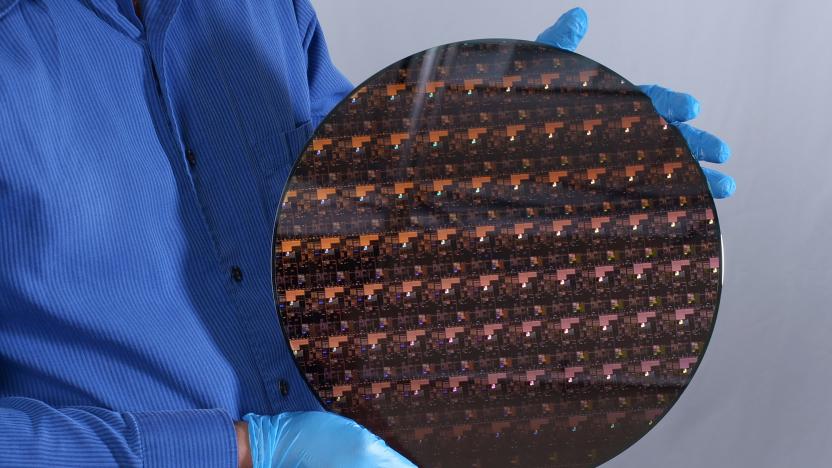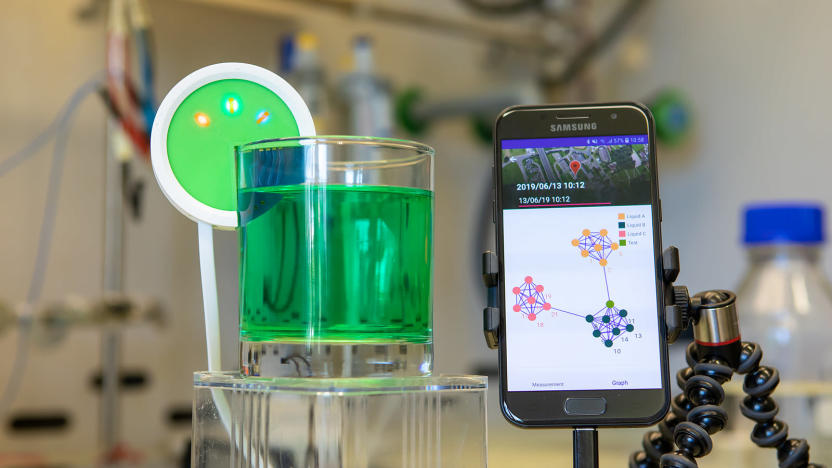ibm research
Latest

IBM says it has created the world's first 2nm chip
The company claims 2nm processors can use 75 percent less power than 7nm-based CPUs for the same performance.

IBM’s cobalt-free EV battery uses materials extracted from seawater
Electric vehicles will play an important role in reducing greenhouse gas emissions, but they are not yet a perfect solution. Today, most EVs run on lithium-ion batteries made with heavy metals like cobalt, of which there is a limited supply and less than ideal mining conditions. The IBM Research Battery Lab may have a solution: a new battery built without heavy metals. It's made, instead, with materials that can be extracted from seawater.

IBM built a robotic tongue to taste test hazardous chemicals
The pace of technical advancement in computer vision systems over the past few years has been nothing short of astounding. The eyes of machines are quickly gaining on their biological counterparts with 1,000-fps vision, the ability to figure out what they're looking at without human aid, and electronic eyes that can be outfitted to any robot. The same goes for tactile sensation and natural language processing, a robot's hands and ears. Research into machine tasting, however, has not seen quite the same degree of enthusiasm. But a new proof-of-concept from IBM Research could give field scientists access to a digital sommelier's palate, even when they're taste testing wastewater for hazardous contaminants.

IBM supercomputer simulates 530 billion neurons and a whole lot of synapses
IBM Research, in collaboration with DARPA's Systems of Neuromorphic Adaptive Plastic Scalable Electronics (SyNAPSE) program, has reached another brain simulation milestone. Powered by its new TrueNorth system on the world's second fastest supercomputer, IBM was capable of crafting a 2.084 billion neurosynaptic cores and 100 trillion synapses -- all at a speed "only" 1,542 times slower than real life. The abstract explains that this isn't a biologically realistic simulation of the human brain, but rather mathematically abstracted -- and little more dour -- versions steered towards maximizing function and minimizing cost. DARPA's SyNAPSE project aims to tie together supercomputing, neuroscience and neurotech for a future cognitive computing architecture far beyond what's running behind your PC screen at the moment. Want to know more? We've included IBM's video explanation of cognitive computing after the break.

IBM: We're on the cusp of the Quantum Computing revolution (video)
Technology's holy grail is the development of a "perfect" Quantum Computer. Traditional computers recognize information as bits: binary information representing "On" or "Off" states. A quantum computer uses qubits: operating in superposition, a qubit exists in all states simultaneously -- not just "On" or "Off," but every possible state in-between. It would theoretically be able to instantly access every piece of information at the same time, meaning that a 250 qubit computer would contain more data than there are particles in the universe. IBM thinks it's closer than ever to realizing this dream and if you want to know more, we have the full details after the break.

IBM's cognitive computing chip functions like a human brain, heralds our demise (video)
After having created a supercomputer capable of hanging with Jeopardy's finest, IBM has now taken another step toward human-like artificial intelligence, with an experimental chip designed to function like a real brain. Developed as part of a DARPA project called SyNAPSE (Systems of Neuromorphic Adaptive Plastic Scalable Electronics), IBM's so-called "neurosynaptic computing chip" features a silicon core capable of digitally replicating the brain's neurons, synapses and axons. To achieve this, researchers took a dramatic departure from the conventional von Neumann computer architecture, which links internal memory and a processor with a single data channel. This structure allows for data to be transmitted at high, but limited rates, and isn't especially power efficient -- especially for more sophisticated, scaled-up systems. Instead, IBM integrated memory directly within its processors, wedding hardware with software in a design that more closely resembles the brain's cognitive structure. This severely limits data transfer speeds, but allows the system to execute multiple processes in parallel (much like humans do), while minimizing power usage. IBM's two prototypes have already demonstrated the ability to navigate, recognize patterns and classify objects, though the long-term goal is to create a smaller, low-power chip that can analyze more complex data and, yes, learn. Scurry past the break for some videos from IBM's researchers, along with the full press release.

IBM rig doesn't look like much, scans 10 billion files in 43 minutes
Someone ought to gift these IBM researchers a better camera, because their latest General Parallel File System is a back-slapping 37 times faster than their last effort back in 2007. The rig combines ten IBM System xSeries servers with Violin Memory SSDs that hold 6.5 terabytes of metadata relating to 10 billion separate files. Every single one of those files can be analyzed and managed using policy-guided rules in under three quarters of an hour. That kind of performance might seem like overkill, but it's only just barely in step with what IBM's Doug Balog describes as a "rapidly growing, multi-zettabyte world." No prizes for guessing who their top customer is likely to be. Full details in the PR after the break.

IBM shows off Smarter Traveler traffic prediction tool
Traffic alerts on GPS devices may be old hat at this point, but there's obviously still plenty of room for improvement, and IBM now says it's managed to do just that with its new "Smarter Traveler" traffic prediction tool. Developed with the help of UC Berkeley's transportation group and the California Department of Transportation, the tool relies on predictive analytics software, GPS monitoring and sensors already on the roads to not only offer alerts, but build a model of each person's usual commuter route. Once the system is trained a bit, commuters are able to check out what's effectively a forecast of their entire route before they even leave the house, rather than simply be alerted to traffic problems before it's too late to avoid them. Head on past for the complete press release, and a quick video explanation of how it works.

IBM says graphene won't fully replace silicon in CPUs
As you may have been able to tell from the flurry of research that's occurred over the past few years (which has even resulted in a Nobel Prize), there's plenty of folks betting on graphene as the next big thing for computing. One of the big players in that respect has been IBM, which first opened up the so-called graphene bandgap and has created some of the fastest graphene transistors around, but is now sounding a slightly more cautious tone when it comes to the would-be demise of silicon-based CPUs. Speaking with Custom PC, IBM researcher Yu-Ming Lin said that "graphene as it is will not replace the role of silicon in the digital computing regime," and further explained that "there is an important distinction between the graphene transistors that we demonstrated, and the transistors used in a CPU." To that end, he notes that unlike silicon, "graphene does not have an energy gap," and that it therefore cannot be completely "switched off," which puts it at quite a disadvantage compared to silicon. Intel's director of components research, Mike Mayberry, also chimed in on the matter, and noted that "the industry has so much experience with it that there are no plans to move away from silicon as the substrate for chips." That doesn't mean that there still isn't a bright future for graphene, though -- Lin gives the example of hybrid circuit, for instance, which could use graphene as a complement to silicon in order to "enrich the functionality of computer chips."

IBM demonstrates 100GHz graphene transistor
It's just been a little over a week since IBM researchers announced that they managed to open up a bandgap for graphene-based field-effect transistors, but they're now already back to show off what that's made possible: a 100GHz graphene transistor. What's more, this latest record-setting transistor (which IBM hopes will one day replace silicon transistors) was made using processing technology that's compatible with that currently used in advanced silicon device fabrication, which should no doubt help speed up its eventual commercialization. Of course, any widespread adoption is still quite a ways away, but IBM says that this new transistor "demonstrates clearly that graphene can be utilized to produce high performance devices and integrated circuits." For those keeping score, this first-of-its-kind transistor already beats the frequency performance of current state-of-the-art silicon transistors of the same gate length, which now top out at a mere 40GHz.







